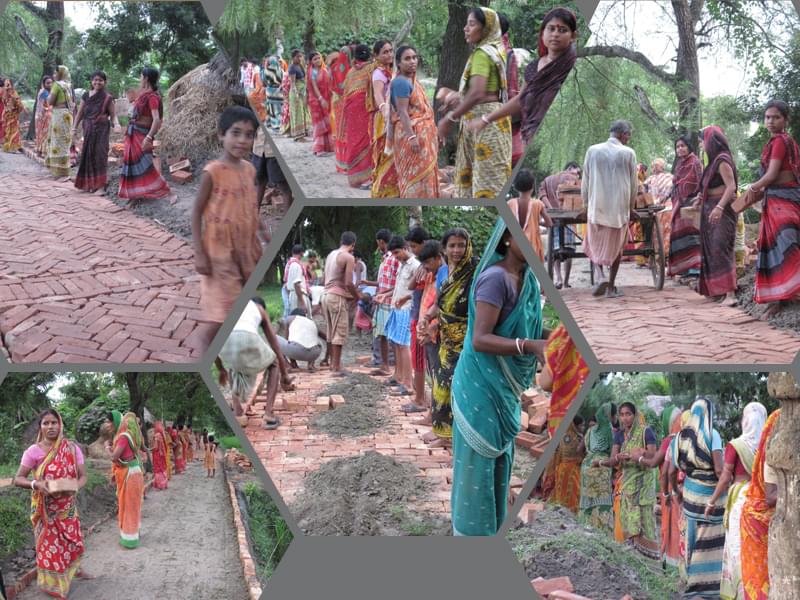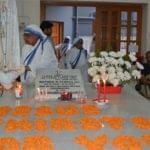Features
Inroads into dense Sundarbans through women laid Brick Lanes

Colony para is just another far-fetched village in remote Sundarban area of South 24 Paragana district of West Bengal. Until recently the village was completely inaccessible to the main world primarily because of the several tributaries surrounding the village in the biggest delta region of the world making it impossible for simple villagers to commute. The lanes were full of mud and the idea of concrete streets for this village never crossed any administrator´s mind. The soft heavy muddy path did not connect to the highway and people had little option but to stay back in their own small world or wade for kilometers in the mud to reach the main road.
Not anymore! The women community of more than fifteen such villages in the vicinity with their men by their side took in the initiative and put in their efforts in the last four years to connect these inaccessible villages by laying down brick lanes. These brick lanes made by the local workforce and resources pooled in the village itself is now the new road to connectivity. The roads have withstood floods and cyclones in the cyclone prone area in one of the most vulnerable ecosystem of the country.
“It seemed we were completely cut off from the world”, says twenty three year old Lotika Sarkar whose husband works as a laborer in Andaman and Nicobar islands. A mother of an eight year old daughter Ankita, she has never gone beyond the block headquarters at Basanti in her district. In class two in the primary school her daughter missed school almost every day in early years of her schooling at the Debnagar colony primary school much to the dismay of her mother. Ankita was born to her mother at home with no medical assistance and she was almost dead at the wee hours in the village. “Due to heavy rains and flood I could not even go anywhere for almost a month after she was born,” says the frail Lotika who had volunteered in laying the road.
With the planning and financial assistance by international humanitarian organization World Vision India, the road map was prepared. World Vision India supported the citizen´s mission and got them the supply of bricks that was used for these roads. The labor cost was borne by the village community not in terms of contributing in money but by serving as the free labor. Roads were built in two layers. The first layer of flat bricks were laid down on the muddy lanes and cemented with crushed brick particles and sand adjusting the fifteen feet wide road in a three kilometer area. These brick lanes finally connected to the main road. Later after the first layer dried out, the gaps were filled with the bricksand paste for smoothening of the roads. Another layer of bricks were laid down and the process repeated making it a pucca brick lane.
Women served as everyday labor for the building process. They would queue up every morning to pass on the bricks to the masons working. Some helped in laying down the bricks in layers. While masons were hired to properly fix it in the first layer, women of the village were the construction laborers. Now when it comes to maintenance and repair, they know how to fix it. They would mix brick sand with mud to repair broken corners and holes on the lanes. Also they efficiently monitor that no one plies a heavy motor vehicle in these lanes.
“It is difficult to lay these brick lanes in these flood affected and delta region. The earth is soft and needs regular upkeep and maintenance”, explains Apam Sat Shang, the project coordinator of the Basanti Development Area of the NGO. “That is why we needed professional masons to build these and so the villagers also generated small funds to pay them for the work and guidance. This also adds to community ownership and bonding”.
The project that was started in 2010 has since been replicated in other fifteen villages changing the mud lanes into brick lanes that connect to the pitch roads and highway. “The project is a continuous process. Till now we have constructed more than eighteen such roads in the vicinity making it more than ten kilometers of brick lanes in the locality”, explains Bhavesh Das who doubles up as a community development coordinator of World Vision and also a community leader who led the project in his gram panchayat.
Another lady Kavita Patro a thirty five year old housewife says, it is a dream come true. “I have been married in this village for fifteen years. But could travel only thrice to my parent´s home. Traveling through the mud and wading in the water to reach to the nearest bus stop or railway station was next to impossible´. Now my daughter rides a bicycle everyday to her high school five kilometers away from here”.
It is not just the case of Kavita or Lotika. Women complain that the children had not been able to avail the Integrated Child Development Scheme (ICDS) at the primary school located in the nearby village. Jharkhali and Nafargunj are the two main gram panchayat area in Basanti block that have taken this community involvement project so that their obscure villages were connected to the mainland. Jharkhali on the southern west coast of river Bidyadhari,is the starting point of the Sundarban Forest Reserve Area infamous for incidents of wild life intrusion in the villages. In absence of proper roads, villagers have for generations lived in fear and without adequate means of livelihood. On the other hand Nafarjung panchayat area facing Malta and Bidyadhari rivers are prone to regular flood and cyclone. Except for fishing and very few other options of livelihood lack of roads have been the biggest hardships of the people. Now with eighteen connecting brick lanes in these areas, lives of more than four thousand five hundred families have changed.
“In fact men in want of adequate work usually migrate to the nearby cities. And who are left behind are the women and children. It is due to these reasons that women still cannot go for institutionalized deliveries of babies and cannot avail government aids”, explains forty five year old Parul Mondol, whose three sons are already married and the two daughter in laws could not be ferried to the nearest health center for their first child birth. “But now we have decided. All women will go to hospital that is sixteen kilometers away for their childbirth.”
Though these roads bring excitement to these villagers as they ride their bicylces and cycle vans, it is still far away when a motor vehicle can be driven in the village. But till then people feel the first stroke of connectivity and freedom through simple these brick lanes.
